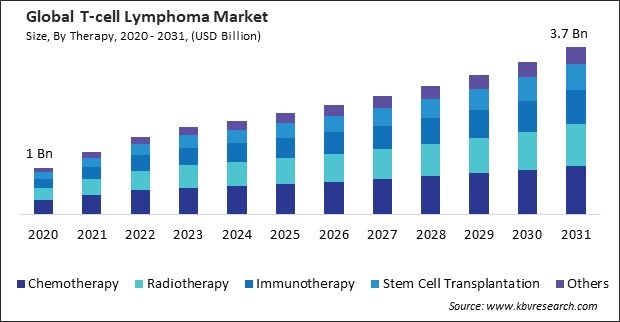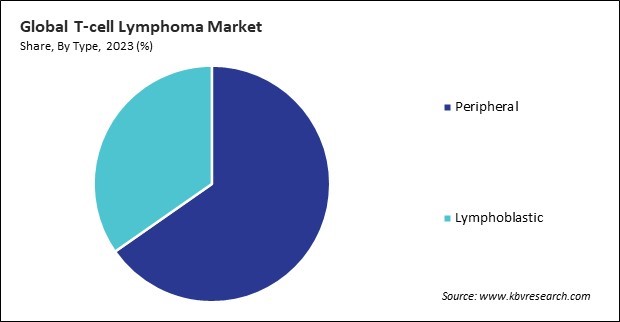“Global T-cell Lymphoma Market to reach a market value of USD 3.7 Billion by 2031 growing at a CAGR of 8.5%”
The Global T-cell Lymphoma Market size is expected to reach $3.7 billion by 2031, rising at a market growth of 8.5% CAGR during the forecast period.
There is a noticeable increase in the incidence of these lymphomas across various countries in the Asia-Pacific region. This rise can be attributed to changing demographics, environmental factors, lifestyle changes, and improved diagnostic capabilities, leading to better detection and reporting. Consequently, the Asia Pacific region would acquire nearly 28% of the total market share by 2031.

Improved understanding of these lymphomas among healthcare professionals leads to earlier disease detection. In addition, advances in diagnostic technologies, such as molecular profiling, flow cytometry, and imaging techniques, enhance the accuracy and reliability of these lymphoma diagnosis. Therefore, increasing disease awareness and diagnosis is driving the market's growth. Additionally, Higher healthcare expenditure typically leads to improved access to healthcare services, including diagnostic tests, specialist consultations, and advanced treatment options for these lymphomas. Furthermore, much healthcare spending goes towards oncology research and development (R&D), including these lymphomas. Thus, rising healthcare expenditure globally is propelling the growth of the market.
However, Advanced treatment modalities for these lymphomas, such as targeted therapies, immunotherapies, and stem cell transplants, are often costly to develop, manufacture, and administer. High treatment costs can create barriers to market access for pharmaceutical companies developing new therapies for these lymphomas. In conclusion, the high cost of treatment and healthcare services hinders the market's growth.
Restrictions on in-person visits, prioritization of COVID-19 trials, and logistical challenges hindered the progress of research and development efforts. Disruptions in global supply chains affected the availability of essential medications, supportive care therapies, and medical supplies needed to treat T-cell lymphomas. This posed challenges in maintaining continuity of care for patients. Economic uncertainties and healthcare resource reallocations during the pandemic strained healthcare systems and patients' financial resources. Access to specialized care and expensive treatments for T-cell lymphomas may have been limited, exacerbating disparities in healthcare access. Thus, the COVID-19 pandemic had a negative impact on the market.
Based on type, the T-cell lymphoma market is divided into peripheral and lymphoblastic. In 2023, the lymphoblastic segment attained 35% revenue share in the T-cell lymphoma Market. T-cell lymphomas, including T-cell acute lymphoblastic leukemia (T-ALL), are relatively rare but often aggressive cancers. Their rapid progression and severity necessitate prompt and effective treatment, increasing the demand for specific therapies.

On the basis of therapy, the market is segmented into radiotherapy, chemotherapy, immunotherapy, stem cell transplantation, and others. In 2023, the radiotherapy segment attained a 26% revenue share in the market. Radiotherapy treats localized lymphomas by delivering high-energy radiation directly to the tumor site.
Free Valuable Insights: Global T-cell Lymphoma Market size to reach USD 3.7 Billion by 2031
Region-wise, the market is analyzed across North America, Europe, Asia Pacific, and LAMEA. The North America region witnessed 39% revenue share in the market in 2023. North America, particularly the United States and Canada, has one of the highest healthcare expenditures globally. This allows for greater affordability and accessibility to advanced diagnostic tools, treatments, and therapies for T-cell lymphomas.
| Report Attribute | Details |
|---|---|
| Market size value in 2023 | USD 1.9 Billion |
| Market size forecast in 2031 | USD 3.7 Billion |
| Base Year | 2023 |
| Historical Period | 2020 to 2022 |
| Forecast Period | 2024 to 2031 |
| Revenue Growth Rate | CAGR of 8.5% from 2024 to 2031 |
| Number of Pages | 208 |
| Number of Tables | 369 |
| Report coverage | Market Trends, Revenue Estimation and Forecast, Segmentation Analysis, Regional and Country Breakdown, Porter’s 5 Forces Analysis, Company Profiling, Companies Strategic Developments, SWOT Analysis, Winning Imperatives |
| Segments covered | Type, Therapy, Region |
| Country scope |
|
| Companies Included | Bristol Myers Squibb Company, Daiichi Sankyo Company, Limited, Eisai Co., Ltd, Acrotech Biopharma Inc. (Aurobindo Pharma USA), Shenzhen Chipscreen Biosciences Co., Ltd., Citius Pharmaceuticals, Inc., Genor Biopharma Co. Ltd., Innate Pharma SA and Dizal Pharmaceutical Co. Ltd. |
By Type
By Therapy
By Geography
This Market size is expected to reach $3.7 billion by 2031.
Increasing disease awareness and diagnosis are driving the Market in coming years, however, High cost of treatment and healthcare services restraints the growth of the Market.
Bristol Myers Squibb Company, Daiichi Sankyo Company, Limited, Eisai Co., Ltd, Acrotech Biopharma Inc. (Aurobindo Pharma USA), Shenzhen Chipscreen Biosciences Co., Ltd., Citius Pharmaceuticals, Inc., Genor Biopharma Co. Ltd., Innate Pharma SA and Dizal Pharmaceutical Co. Ltd.
The expected CAGR of this Market is 8.5% from 2024 to 2031.
The Peripheral segment led the Market by Type in 2023; thereby, achieving a market value of $2.3 billion by 2031.
The North America region dominated the Market by Region in 2023, and would continue to be a dominant market till 2031; thereby, achieving a market value of $1.4 billion by 2031.
Our team of dedicated experts can provide you with attractive expansion opportunities for your business.

 Drivers
Drivers
 Restraints
Restraints
 Opportunities
Opportunities
 Challenges
Challenges
